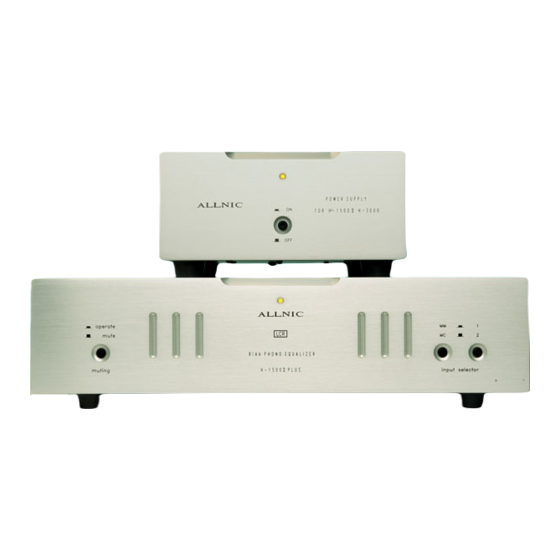ALLNIC AUDIO H?1500 II PLUS PHONO STAGE Manuel du propriétaire - Page 4
Parcourez en ligne ou téléchargez le pdf Manuel du propriétaire pour {nom_de_la_catégorie} ALLNIC AUDIO H?1500 II PLUS PHONO STAGE. ALLNIC AUDIO H?1500 II PLUS PHONO STAGE 12 pages. Phono stage

INTRODUCING THE H‐1500 II PLUS PHONO STAGE
The H‐1500 II PLUS is Allnic Audio's mid‐line phono
stage model, just under the top of the line H‐3000.
Like all Allnic Audio products, it uses Permalloy (iron
and nickel alloy) for its transformer cores. Allnic is
grateful to Mr. G.W. Elmen of Western Electric for
inventing Permalloy for transformer core use, and in
so doing, providing an enormous service to
recorded music listeners everywhere.
The H‐1500 II PLUS has the following features:
•
LCR TYPE RIAA EQUALIZATION:
RIAA equalization is a specification for the correct
playback of vinyl records, established by the
Recording Industry Association of America. The
purpose of the equalization is to permit longer
playback times and improve sound quality.
RIAA equalization is a form of establishing a flat
frequency response for the playback of recorded
music. The necessity for this equalization process
arises from mechanical difficulties inherent in
record production. In order to prevent the
cutting needle from over‐cutting into the next
record groove in the bass, as a record is cut,
some bass frequencies are attenuated. In the
treble region, in order for high frequency sounds
not to be masked by the noise inherent in
moving a stylus over and through a modulated
vinyl surface, some treble frequencies are
boosted. With the application of the correct
filtering techniques on playback, the result is a
flat frequency response with better signal to
noise ratios.
There are four de‐emphasis methods that can be
applied at playback:
A.
Active filters (Negative feedback types):
Different quantities of negative feedback are
applied, with deeper feedback to the high
frequencies and shallower to the low
frequencies. The benefits of this method are
improved signal to noise ratios, low cost and
consistent operation. Some of the shortfalls are
looser bass reproduction and possibly a pinched
and compressed high frequency playback due to
excess feedback ratios.
B. Passive filters (CR type):
‐
The frequencies are filtered to fit the RIAA
specification by varying the amount of attenuation
at different frequencies through a complex
capacitor‐resistor network. This technique results
in no voltage overload, purer reproduction
(because there is no feedback), and more accurate
RIAA compensation. However, there are problems
because the system provides no gain, and
insertion loss and impedance matching issues
arise.
C. Hybrid filters (use of both CR and negative
feedback types):
In this method, both types of filters applied
separately; an active filter is applied to the low
frequencies and a passive filter to the high
frequencies. Unfortunately, both the advantages
and disadvantages of each of these two types of
filters, already discussed, affect the playback
system at the same time.
D. LCR filters, which are used in the H‐1500 II
PLUS:
Two pieces of a linear reactor (a kind of choke coil)
comprise the main part of these filters, assisted by
precise CR filters, in order to lower impedances
and insertion loss. In vacuum tube circuits, active
and passive filters usually are operated on one
hundred plus kilo ohms of impedance. An LCR
RIAA filter's impedance is a constant 600 ohms.
Furthermore, an LCR RIAA filter's series resistance
is less than 13 ohms (as a comparative, some
famous ones are 31 ohms). The lower the
impedance, the more dynamic is the sound
reproduction, with better bass response and
speed.
4
